Lasagna Bolognese is rich and saucy casserole made by layering pasta, meaty bolognese sauce, and creamy parmesan béchamel. This dish is comfort food 101 and designed to spoil yourself and everyone you love.
Even though traditional Lasagna Bolognese does not contain cheese, this recipe gives you the option to add some if you like.
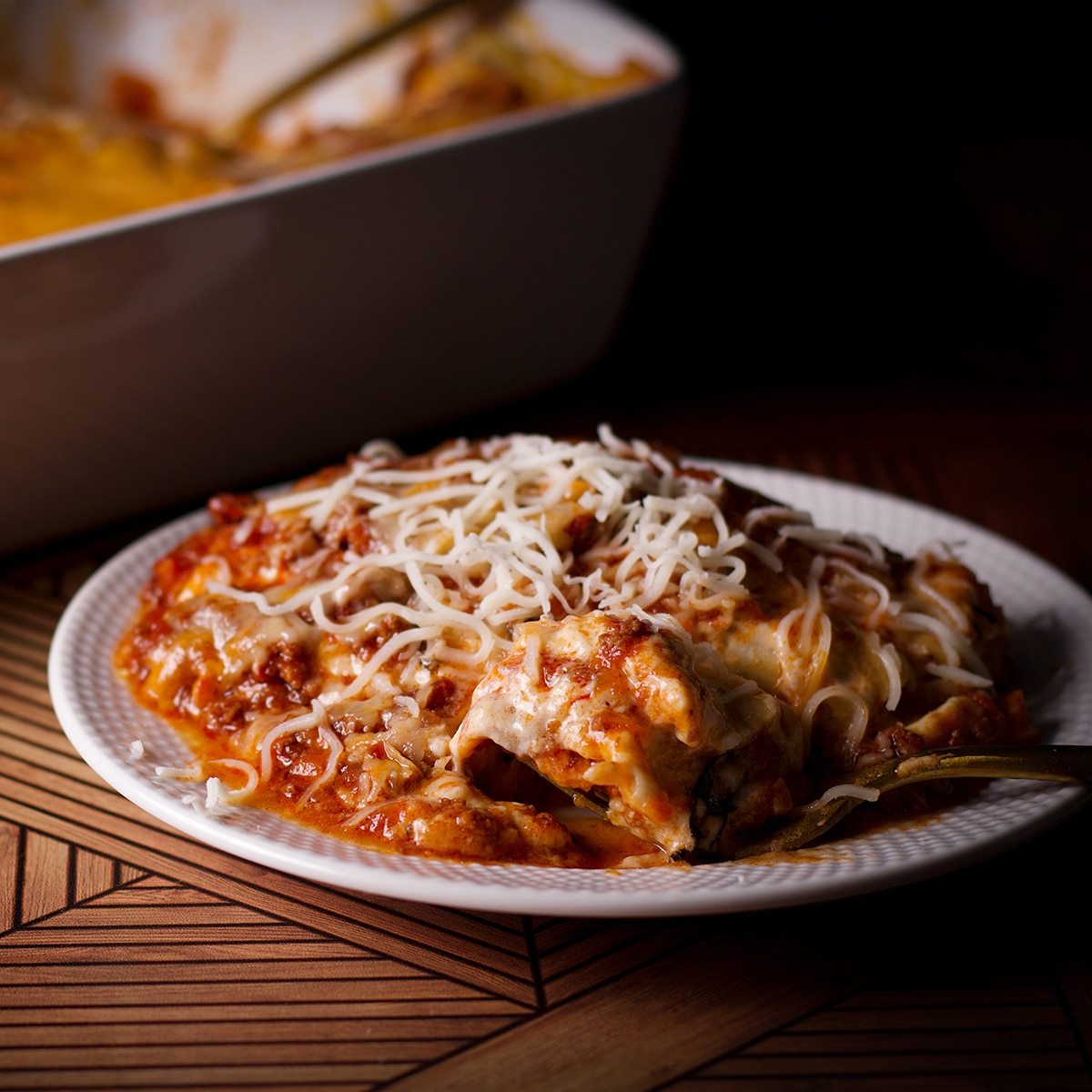
"It's been three months that my children have been begging me to recreate lasagna bolognese from one of our trips where this was apparently the best dish they ever had. Since then, I've been trying to follow various recipes and methods but cannot get it right. This is LITERALLY the most amazing of the lot. My babies are still licking their fingers, and it turned out EXACTLY like what we tried on our trip. LOVE IT!!" - Susie

+ Subscribe to my newsletter for new and exclusive recipes in your in-box every month! As a full time traveler, living, working, cooking, and baking from a 5th wheel RV, it's also where I share our experiences of life on the road.
What is Lasagna Bolognese?
When many of us think about lasagna, we imagine the "classic" variety - pasta layered with marinara, sausage and plenty of ricotta and mozzarella cheese.
But there are and endless number of variations, from pesto and potato lasagna to Asian short rib lasagna to skillet vegetable lasagna, because "lasagna" is more of a category than a specific dish.
Lasagna Bolognese begins, of course, with Bolognese sauce, a gorgeous sauce that includes pancetta (or bacon) and ground beef cooked slowly in wine and tomatoes until it's incredibly rich and flavorful. Instead of ricotta, lasagna bolognese includes layers of creamy béchamel, usually flavored with grated parmesan.
"Traditional" lasagna bolognese does not include the addition of grated cheese within its layers. But, traditions are made to be broken, and I nearly always add some grated cheese between the layers of pasta, Bolognese sauce, and béchamel.
Whether or not you add some grated cheese is 100% up to you. Thanks to the creamy béchamel sauce, this lasagna is delicious with or without it.
Ingredients
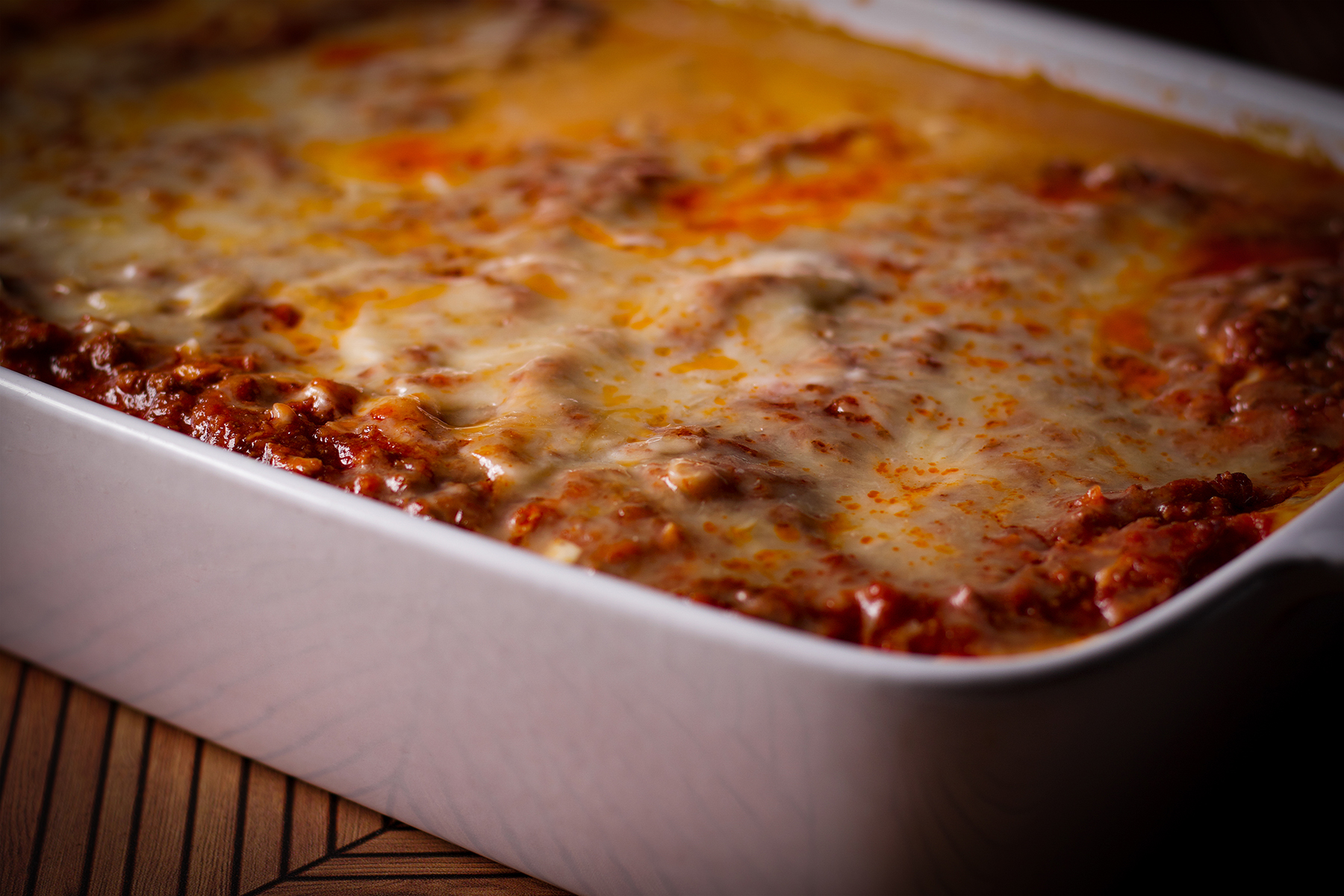
This lasagna recipe is prepared by layering these 4 ingredients:
- Béchamel sauce (besciamella) is a creamy sauce made from a white roux (flour and butter) and milk. The parmesan version used in this recipe is rich, creamy, and positively luxurious. It's also surprisingly simple to make.
- Bolognese sauce (agù alla bolognese) is a rich, meaty, tomato based sauce that includes ground beef and small bits of fatty pork such as pancetta or bacon. There are several ways to make a good Bolognese sauce, but this recipe with bacon and wine is my favorite.
- Pasta: 12 oven ready no-boil lasagna noodles OR 1 pound fresh pasta dough, rolled into sheets
- More cheese! In addition to the parmesan that's melted into the creamy white béchamel sauce, even more cheese is layered into this lasagna because in my book, the best lasagna is the cheesiest lasagna.
Pro tip! Make the Bolognese sauce in advance.
Just like a good marinara sauce, bolognese needs a long, slow simmer to concentrate the flavor and thicken into the glorious culinary masterpiece that it is. So, if you're making the sauce on the same day you plan to bake lasagna, start early.
Bolognese sauce can also be made in advance and stored in the refrigerator for up to 2 days. You can freeze Bolognese sauce, although I find that the texture of the ground beef suffers a bit from freezing. In general, I prefer to make the sauce within a day or two of making lasagna.
Step-by-step photos and instructions
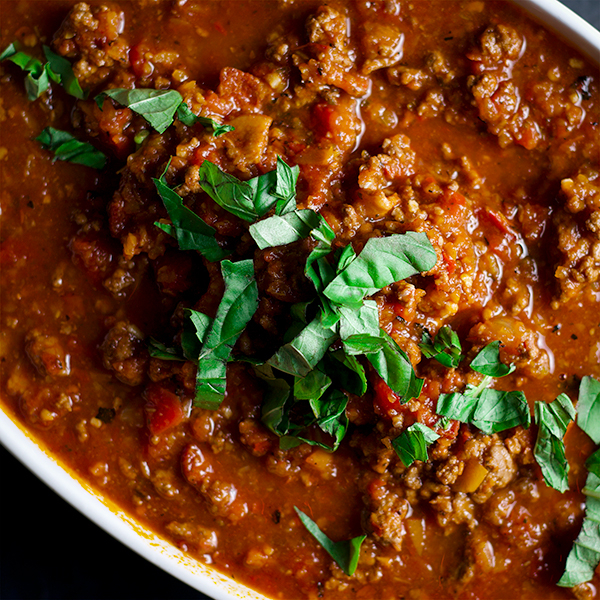
Make the bolognese sauce. The sauce needs to simmer for a couple of hours, so plan ahead. It can also be prepared up to 3 days in advance and kept in the refrigerator until you're ready to use it to make lasagna.
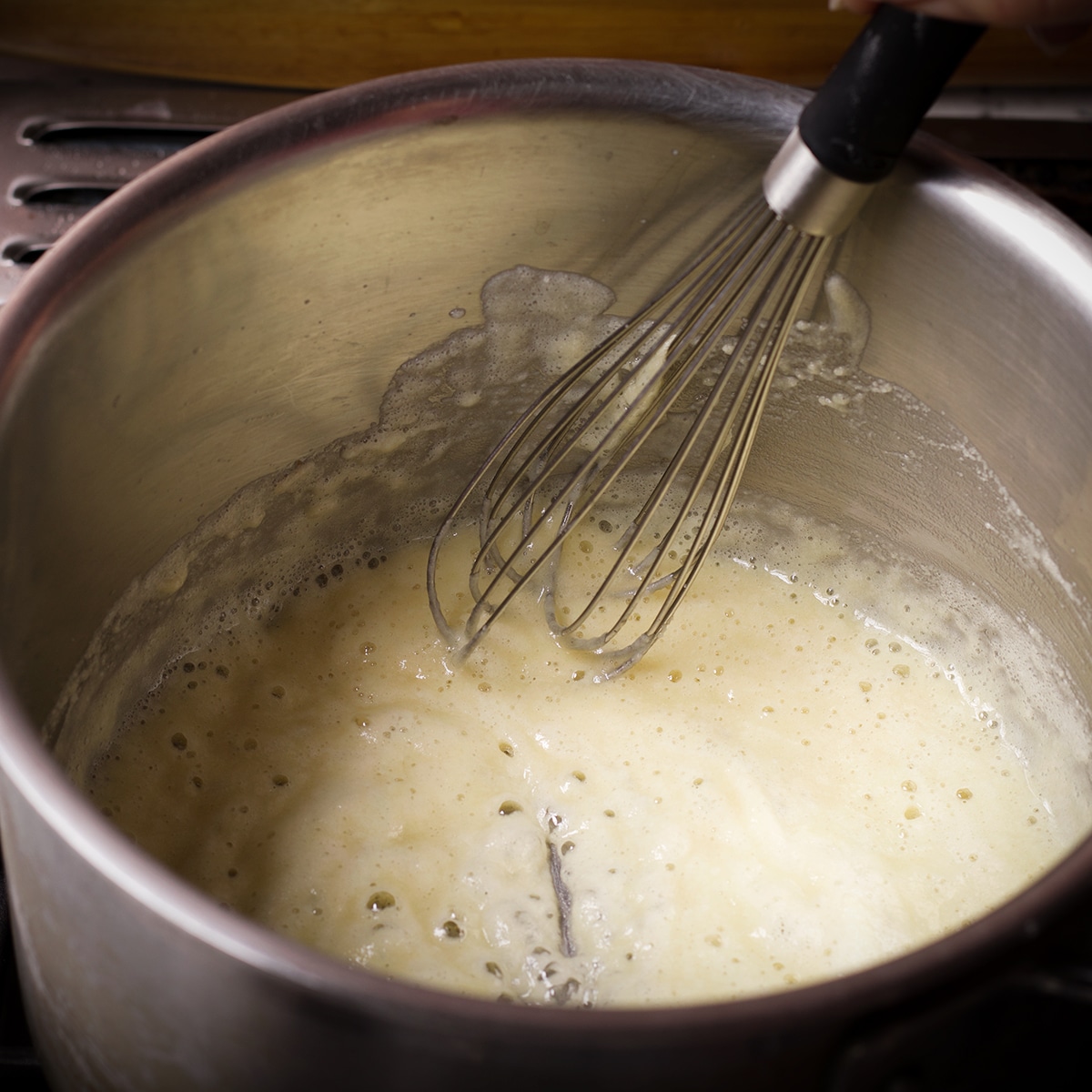
To make the parmesan béchamel sauce, start by melting some butter in a medium size saucepan.
When the butter is melted, add some flour. Cook the butter and flour, whisking constantly, for a couple of minutes. This is the roux, which will thicken the Béchamel sauce.
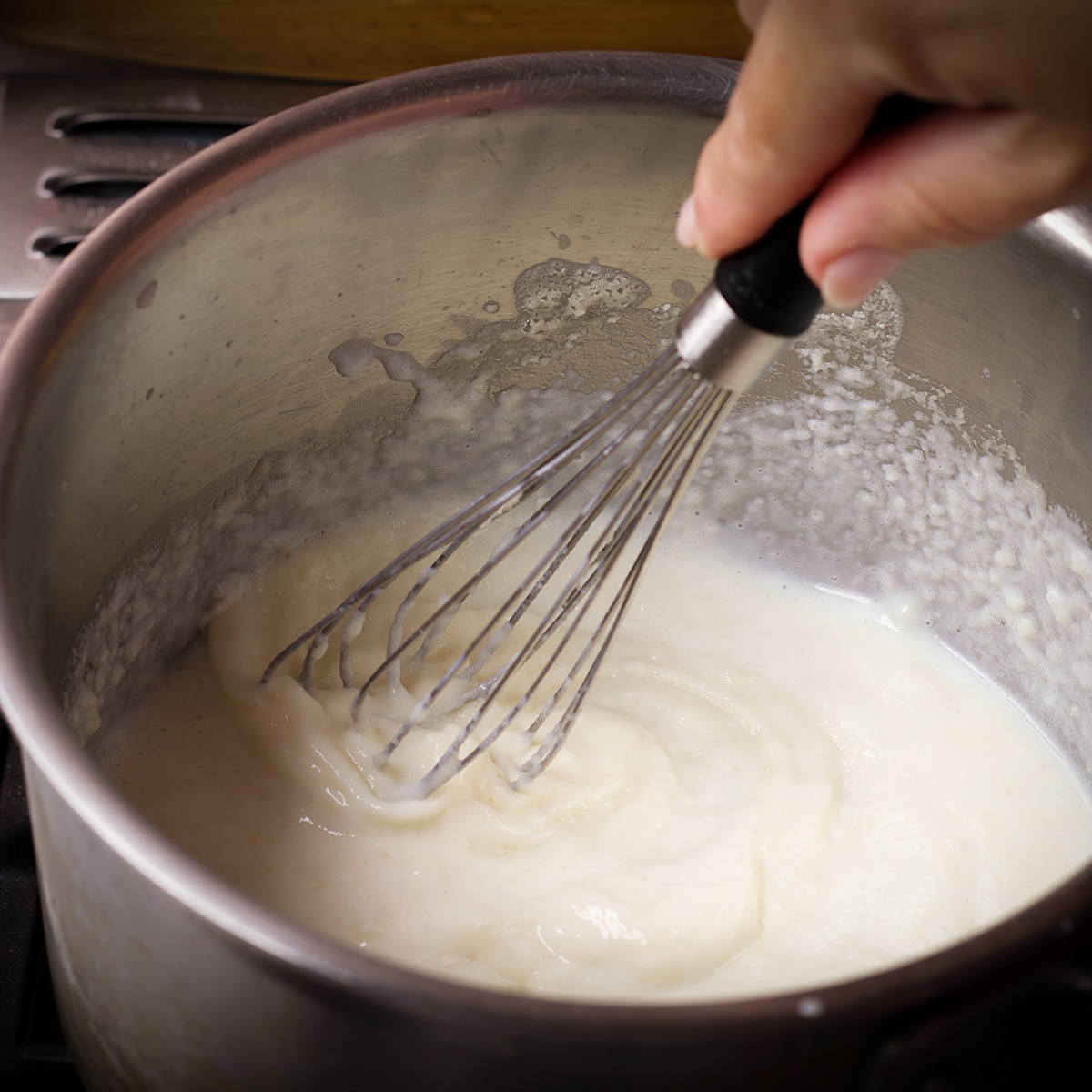
Very slowly start to add the milk or half & half. It's important to add the liquid to the roux slowly. Adding it quickly will cause the sauce to be lumpy.
It's also very important to whisk constantly while adding the liquid to help incorporate the liquid into the roux and keep the sauce from burning.
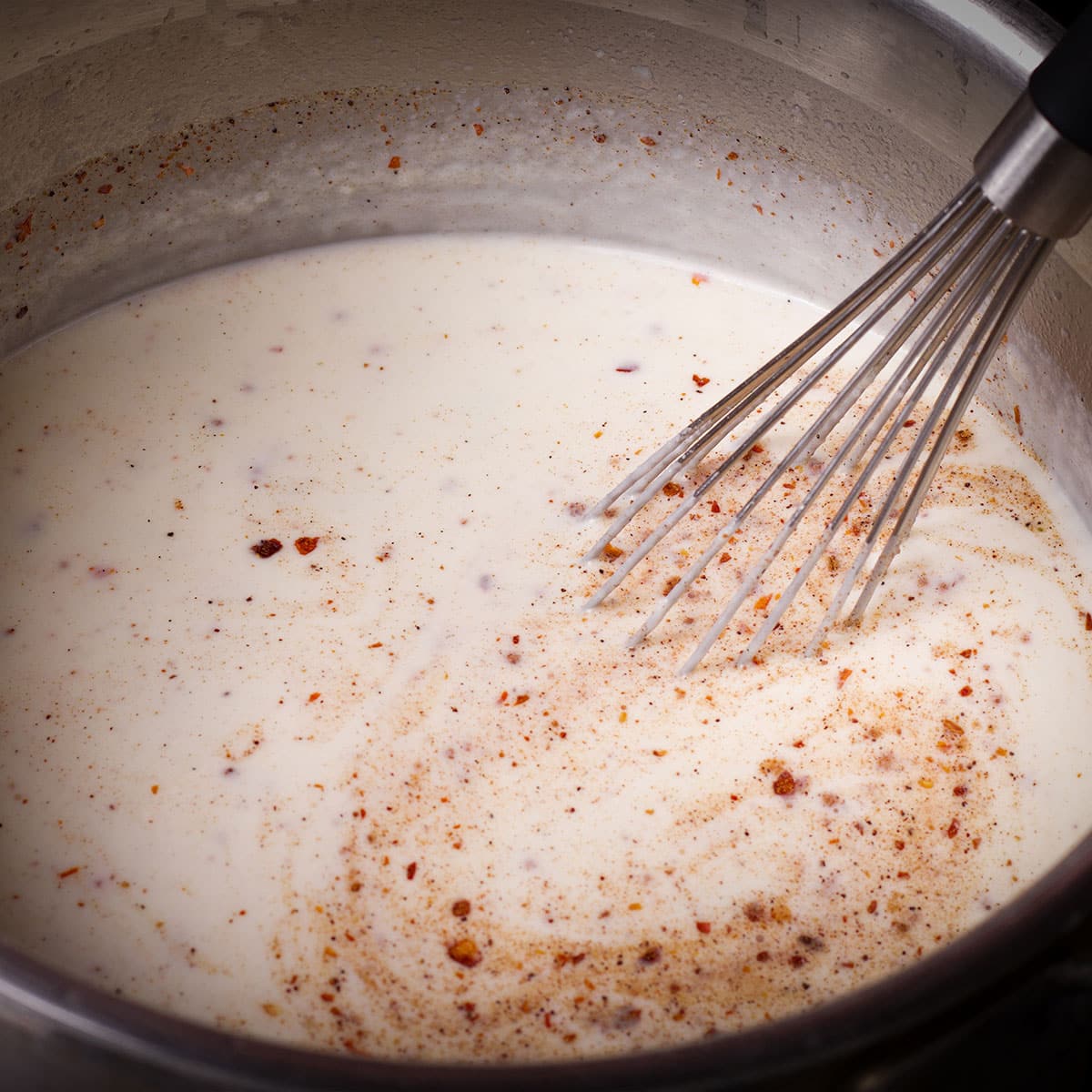
Once all the milk or half & half has been added whisk in the nutmeg and red pepper flakes and bring the sauce to a simmer.
Continue to cook, stirring frequently, until the béchamel is thickened and does not taste like raw flour, about 10-12 minutes
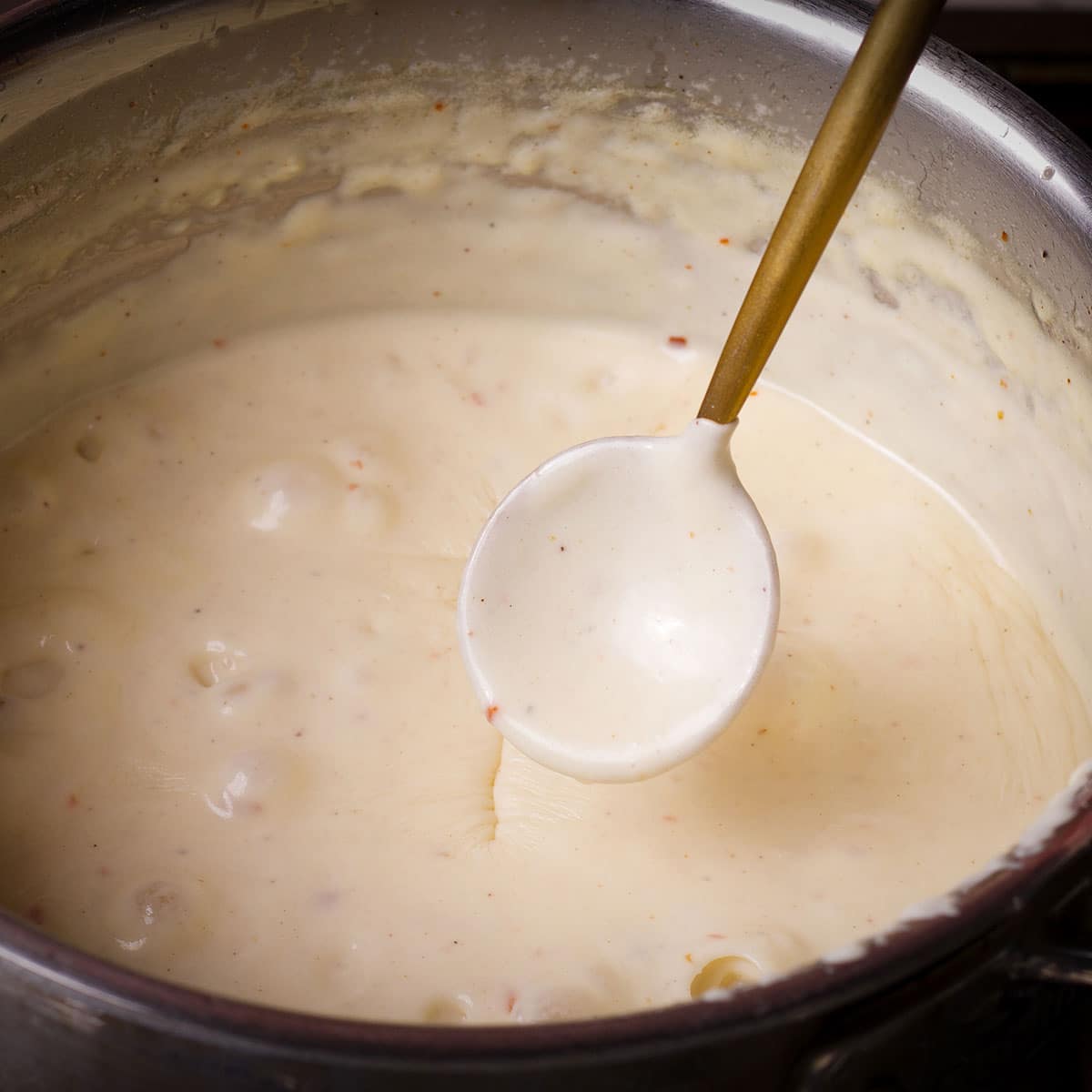
The sauce should be thick enough to coat a spoon.
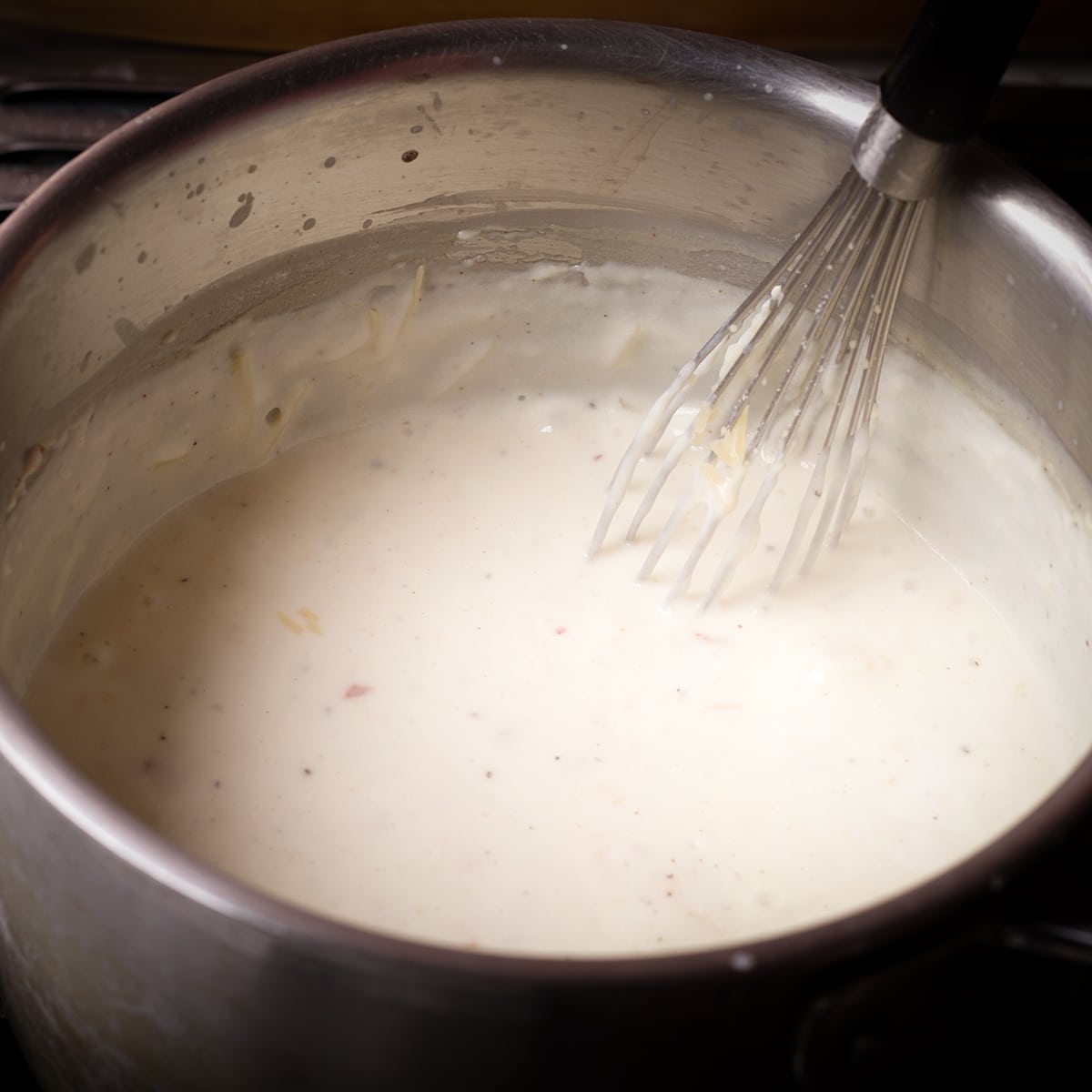
Add grated parmesan and cook, stirring constantly, until the cheese is melted.
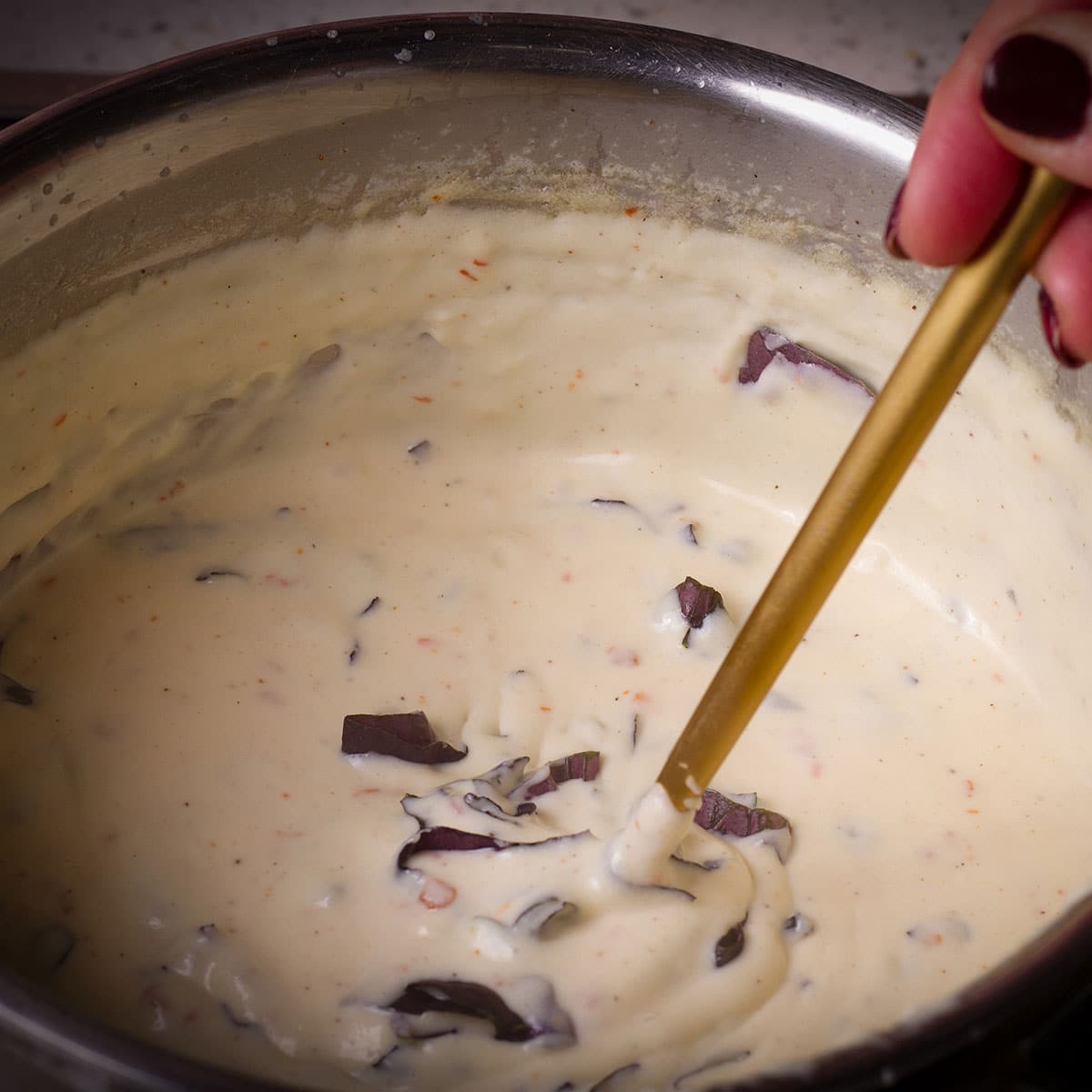
Remove the pan from the heat and stir in chopped fresh basil. Add salt and pepper to taste, cover, and set aside.
At this point you can cover the sauce and keep it in the refrigerator for up to 24 hours.
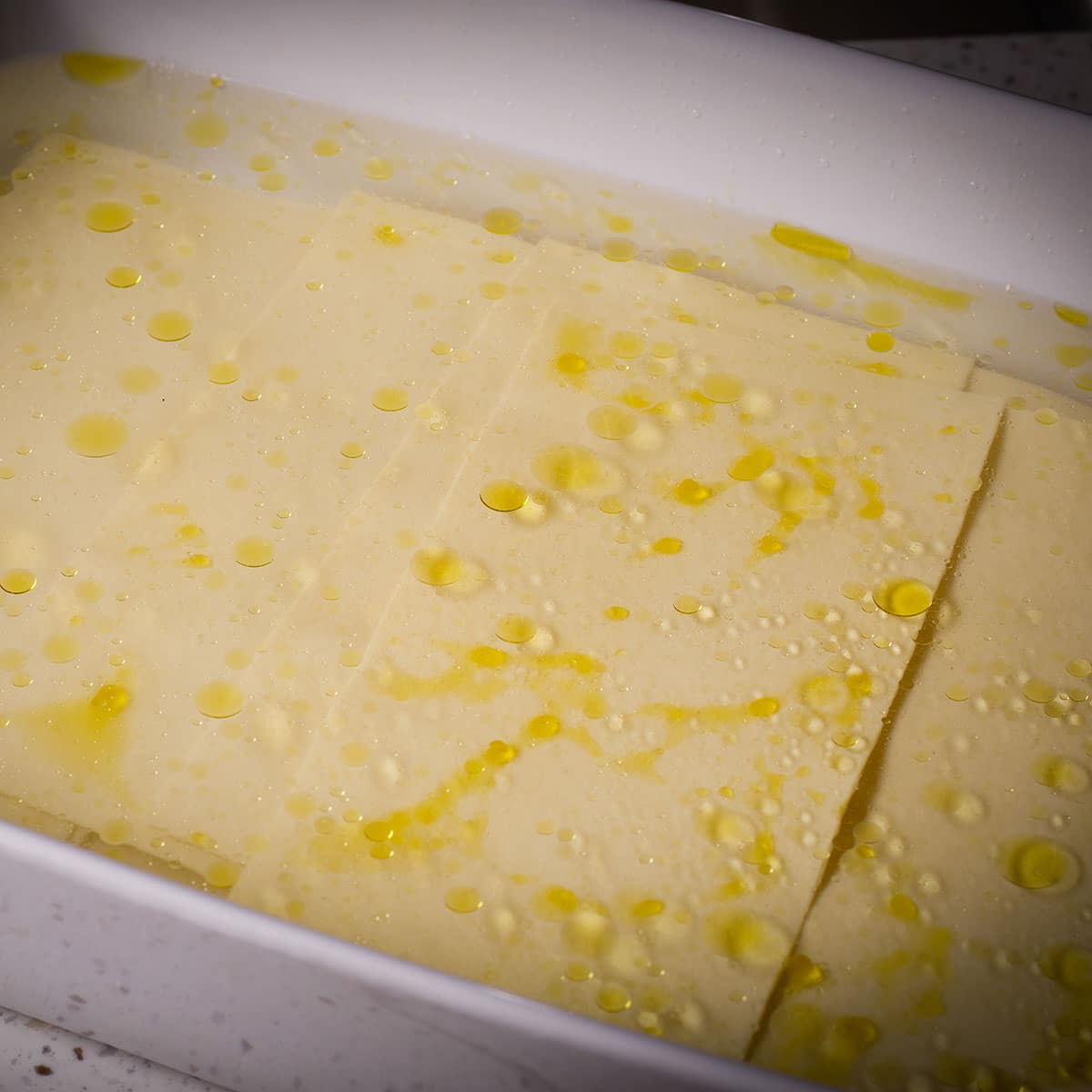
If using oven ready lasagna noodles soak the noodles in hot water for a few minutes. This will prevent them from absorbing too much moisture from the béchamel and bolognese sauces. After soaking, simply lay the noodles out on a clean kitchen towel, blotting them with a paper towel to dry.
Time to layer!
Layer #1: Spread 1 cup Bolognese sauce over the bottom of a 9x13-inch rectangle baking dish, preferably ceramic or glass. Do NOT use an aluminum pan as the aluminum can react to the acid in the bolognese sauce and cause the lasagna to take on an off-putting metallic flavor.
Place 4 noodles in a single layer over the sauce then spread the noodles with 1 cup of the parmesan béchamel.
Pour 1 ½ cups Bolognese sauce over the béchamel, spreading it out into an even layer. Then, sprinkle the bolognese with ½ cup (2 ounces) cheese, if using.
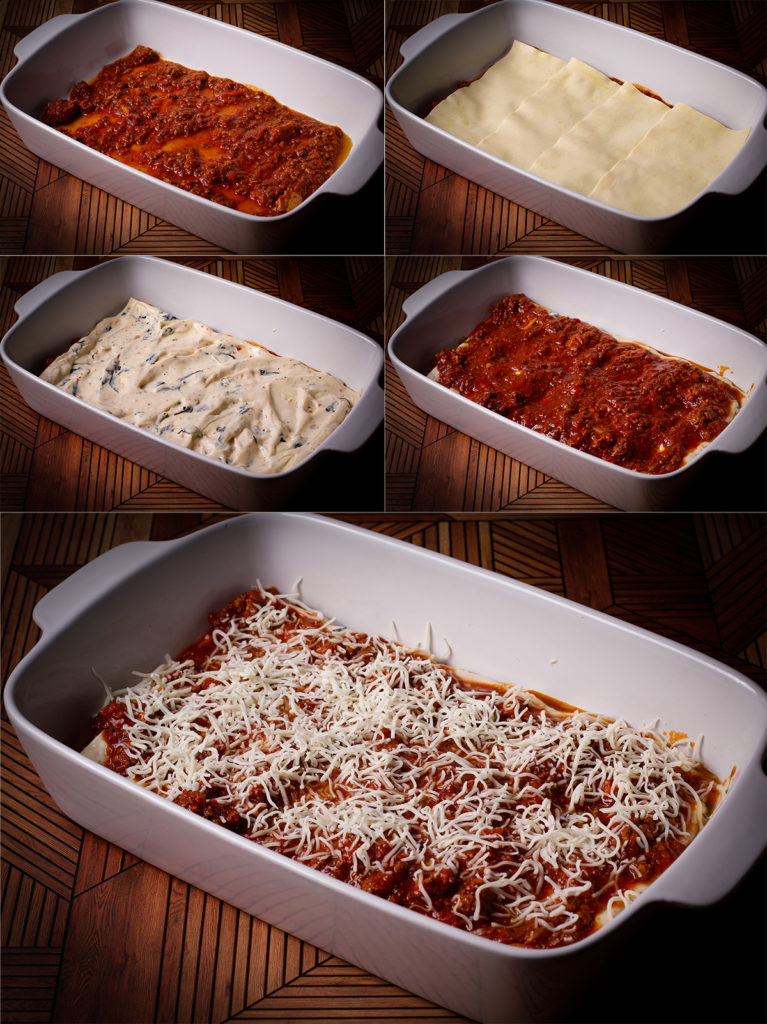
Layer #2: Lay 4 more noodles in a single layer over the first layer.
Spread another cup of the the parmesan béchamel over the noodles, followed by another 1 ½ cups of Bolognese sauce.
Sprinkle the bolognese with ½ cup (2 ounces) cheese.
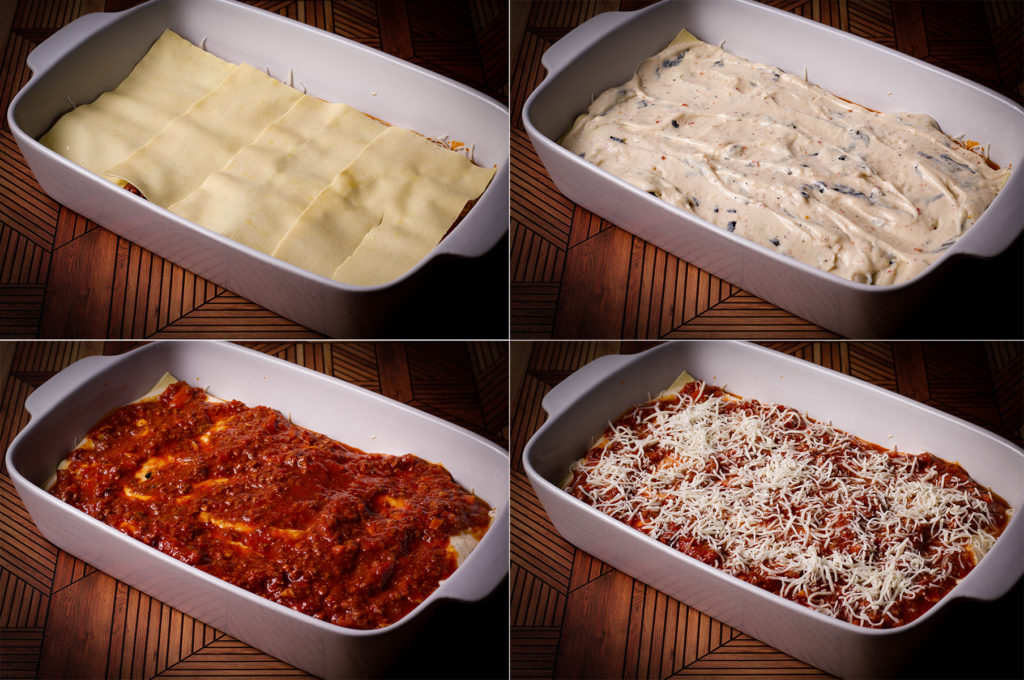
Layer #3: Lay the remaining 4 noodles in a single layer over layer #2.
Spread the rest of the parmesan béchamel over the noodles, followed by the remaining Bolognese sauce.
If you're using extra grated cheese, sprinkle the remaining cup over the top of the lasagna.
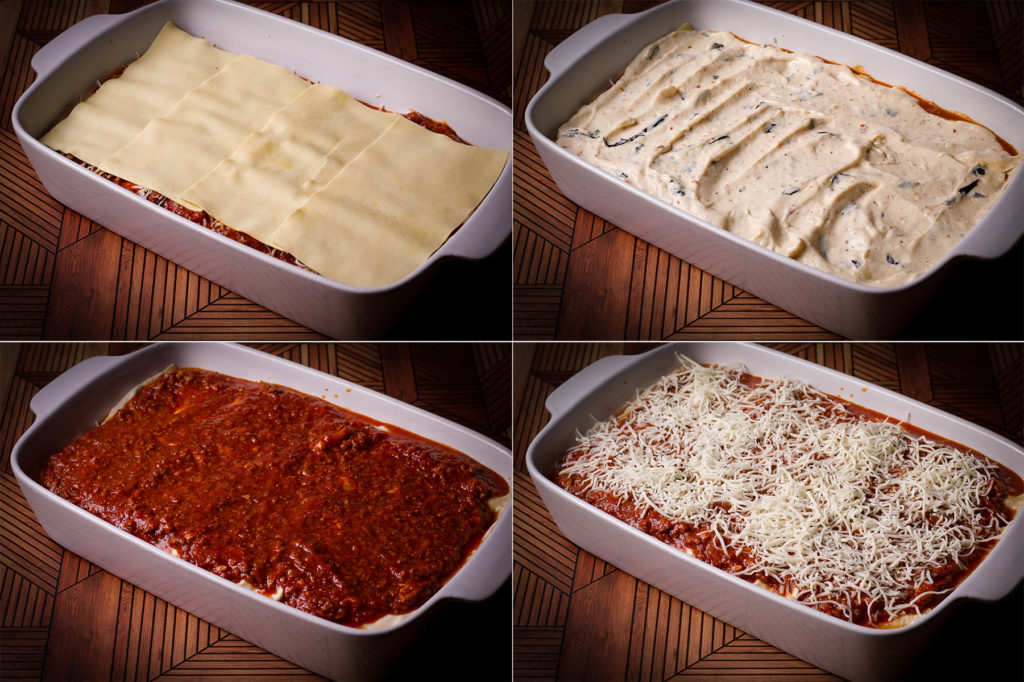
Cover the lasagna with a sheet of aluminum foil (or parchment paper, or the lid to your casserole dish if you have one). If using foil, spray it with a bit of non-stick spray to prevent the cheese from sticking to it.
Bake the lasagna until the sauce is all bubbly around the edges, about 45 minutes - 1 hour.
Even though it's SUPER hard to wait, let the lasagna rest for 15-20 minutes before cutting into it. This will help the liquids in the lasagna to be reabsorbed into the casserole, making it easier to slice.
Full disclosure: Even after resting, this is a sloppy, saucy kind of lasagna which is just the way we like it.
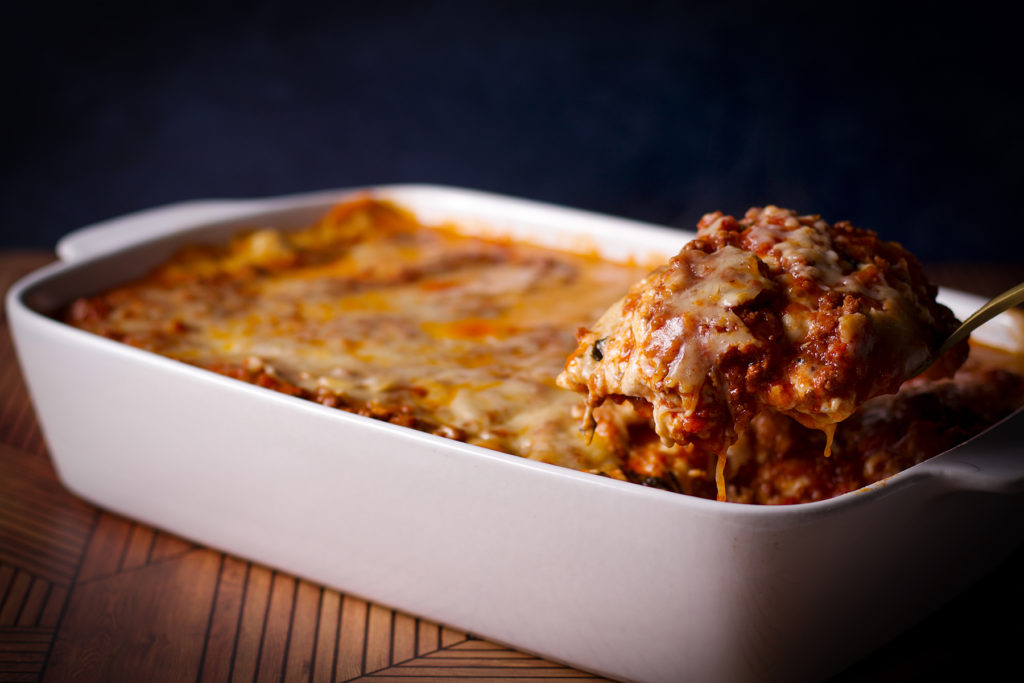
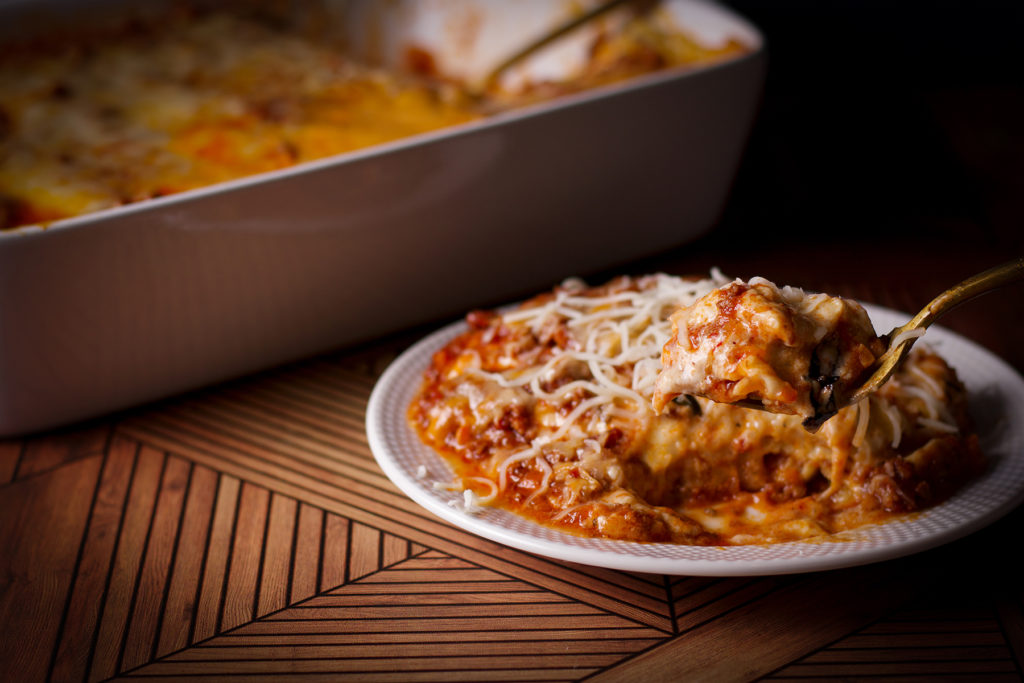
What's the best kind of pasta for lasagna?
I have made lasagna with fresh sheets of pasta, regular dried lasagna noodles that have been boiled, and oven ready no-boil lasagna noodles. My two favorite options are:
- Oven ready no-boil noodles
- Fresh sheets of homemade pasta
If using no-boil oven ready lasagna noodles, I recommend soaking the dried sheets of pasta for about 10 minutes in hot water. Pre-soaking the noodles prevents them from absorbing too much moisture from the béchamel sauce and will produce a creamier lasagna.
To soak the noodles, simply lay them out in a baking dish, drizzle them with a bit of olive oil and sprinkle with salt. Then, add enough hot water to cover the noodles. Swish them around in the pan and then let them soak for 10 minutes.
After soaking, simply lay the noodles out on a clean kitchen towel, blotting them with a paper towel to dry.
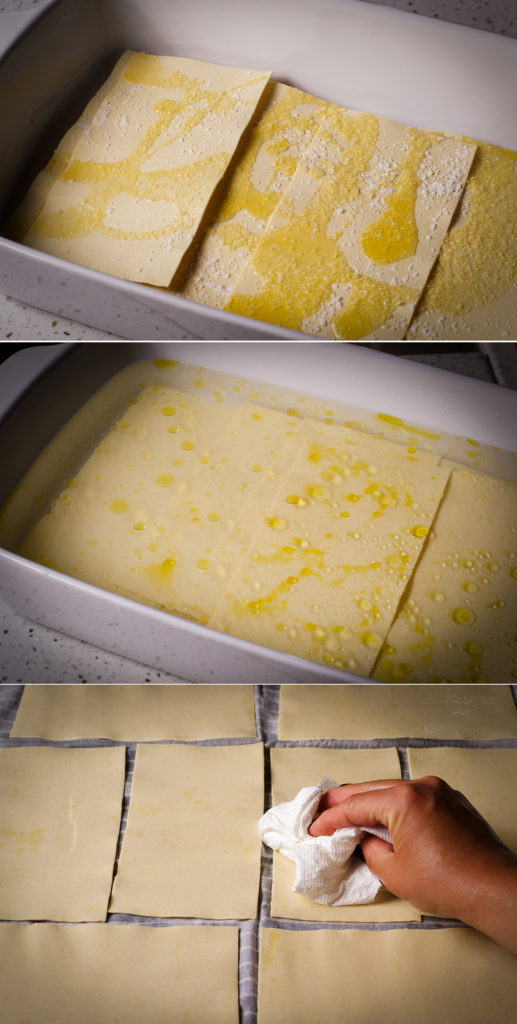
FAQs and expert tips
Besides the parmesan folded into the Bechamel sauce, Lasagna Bolognese does not traditionally include additional cheese. So, in this recipe, layering in some extra cheese is optional.
If you do opt for adding cheese to your lasagna, look for an Italian blend of grated cheese. Italian blend ususally includes Parmigiano-Reggiano and Pecorino Romano, mozzarella and provolone
Yes! You can make a meatless version of Lasagna Bolognese by just substituting one of the is many vegan meat substitutes on the market today. Or, use chopped mushrooms in place of the ground beef in classic bolognese sauce.
Two other great meatless options is to make this white mushroom lasagna or this skillet vegetable lasagna.
Yes! Bolognese Sauce can be made up to 3 days in advance of using for this lasagna. Store it in the refrigerator in a covered container. Warm over low heat, stirring frequently to prevent the bottom from scortching. Or, reheat in the microwave, stopping to stir every 60 - 90 seconds, until warm.
Parmesan béchamel can be made up to a day in advance of using it for this lasagna. Store it in the refrigerator in a covered container. Warm over low heat, whisking until smooth.
The assembled, uncooked lasagna can be prepared up to 1 day in advance. Cover, and keep in the refrigerator until ready to bake.
Once cooked, lasagna bolognese will keep in the refrigerator, covered, for up to 2 days.
Yes! It's important to freeze lasagna before cooking it. Assemble the lasagna cold. This means using cold pasta, cold bolognese sauce, and cold béchamel. I also recommend using whole milk to make the béchamel sauce instead of half and half if you plan to freeze this lasagna.
Cover the lasagna tightly and freeze for up to 3 months. Allow the lasagna to thaw in the refrigerator overnight then follow these instructions for the best way to reheat lasagna.
More cheesy, saucy recipes
- Lasagna Béchamel with Mushroom Ragù {Meatless}
- The BEST Classic Lasagna with Italian Sausage and Marinara
- Asian Short Rib Lasagna
- Skillet Vegetable Lasagna
- Extra Cheesy Ricotta Stuffed Shells
- How to Make Eggplant or Chicken Parmesan

+ Subscribe to my newsletter for new and exclusive recipes in your in-box every month! As a full time traveler, living, working, cooking, and baking from a 5th wheel RV, it's also where I share our experiences of life on the road.
If you give this recipe a try, let me know! Scroll down to rate this recipe and leave a comment or question, or take a picture and tag it @alittleandalot on Instagram.
📖 Recipe
Lasagna Bolognese with Parmesan Béchamel
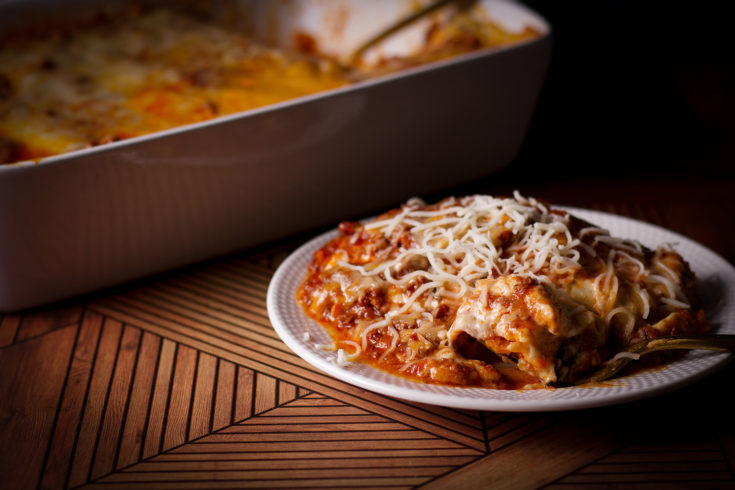
Lasagna Bolognese is rich and saucy casserole made by layering pasta, meaty bolognese sauce, and creamy parmesan béchamel. Even though traditional Lasagna Bolognese does not contain cheese, this recipe gives you the option to add some if you like.
Ingredients
For the Parmesan Béchamel:
- 6 tablespoons (3 ounces/ 84 grams) salted butter, cut into 6 pieces
- ¼ cup (30 grams) all-purpose flour
- 4 cups (1 quart) half and half or whole milk
- ½ teaspoon ground nutmeg
- 1 teaspoon crushed red pepper flakes
- Salt and pepper
- 4.5 ounces (1 ½ cups) finely grated parmesan cheese
- ½ cup, packed (.6 ounces) chopped fresh basil
For the Lasagna:
- 12 oven ready, no-boil lasagna noodles or or 1 pound fresh pasta dough, rolled into sheets
- 1 tablespoon extra virgin olive oil
- 6 cups Bolognese sauce, warmed
- 3 cups (12 ounces) grated Italian blend cheese
- 1-2 cups (3-6 ounces) grated parmesan, for serving (optional)
Instructions
Make the Parmesan Bechamel:
- Add the butter to a 3 quart or larger saucepan and set it over medium heat. When the butter is melted, add the flour, stirring constantly with a wire whisk. Cook, whisking constantly, for 2 minutes.
- Add the half and half gradually, whisking constantly as you slowly pour it into the saucepan. Add the nutmeg and red pepper flakes and bring the sauce to a simmer.
- Cook over medium-low heat, whisking frequently, until the Bechamel is thickened and does not taste like raw flour, about 12 minutes. (The sauce should be thick enough to coat a spoon; see photos above.)
- Remove the saucepan from the heat and whisk in 4.5 ounces grated parmesan, stirring until the cheese is melted.
- Stir in the fresh basil. Add salt and pepper to taste, then cover and set aside. (*See notes below for make-ahead instructions.)
Make the Lasagna:
- Heat oven to 350 degrees F (176 degrees C). If using oven ready no-boil lasagna noodles, see the note below about pre-soaking them before layering them into the lasagna. If using fresh pasta, roll the pasta dough into thin sheets and then cut the sheets to fit the pan.
- Layer #1: Spread 1 cup bolognese sauce over the bottom of the baking dish. Place 4 noodles in a single layer over the sauce. Spread 1 cup (⅓ of the sauce) of the parmesan béchamel over the noodles. Pour 1 ½ cups of the bolognese over the béchamel, spreading it out into an even layer. Sprinkle the bolognese with ½ cup (2 oz) cheese, if using.
- Layer #2: Lay 4 noodles in a single layer over layer #1. Spread 1 cup (⅓ of the sauce) of the parmesan béchamel over the noodles. Pour 1 ½ cups of the bolognese over the béchamel, spreading it out into an even layer. Sprinkle the bolognese with ½ cup (2 oz) cheese, if using.
- Layer #3: Lay 4 noodles in a single layer over layer #2. Spread the remaining parmesan béchamel over the noodles. Spread the , the remaining bolognese over the béchamel. Top with 1 cup (4 ounces) cheese, if using.
- Cover the lasagna tightly with aluminum foil that’s been sprayed with a bit of non-stick baking spray. (The baking spray will keep the cheese from sticking to the foil.) Set the pan on a baking sheet that's been covered with a sheet of aluminum foil (to catch any drips). Bake in the center of the oven until the edges of the lasagna are bubbling, 45 minutes to 1 hour.
- Remove the lasagna from the oven and let the lasagna stand, uncovered, for 15-20 minutes before slicing and serving.
- Serve with additional grated parmesan if desired.
Notes
How to prepare oven ready no-boil noodles: Lay the noodles out in a 9x13 baking dish. Drizzle with the remaining 1 tablespoon olive oil and sprinkle in 1 tablespoon salt. Add enough very hot water (about 140 degrees F/ 60 degrees C) to cover the noodles. Swish the noodles around in the water and then let stand for 10 minutes, moving them around once or twice to ensure they don’t stick together. Remove the noodles from the water and lay them out on a clean kitchen towel. Pat dry with another towel or paper towels. Dump the water out of the baking dish and dry with a towel.
Make Ahead Instructions:
- Bolognese Sauce can be made up to 3 days in advance of using for this lasagna. Store it in the refrigerator in a covered container. Warm over low heat, stirring frequently to prevent the bottom from scorching. Or, reheat in the microwave, stopping to stir every 60 - 90 seconds, until warm.
- Parmesan béchamel can be made up to a day in advance of using it for this lasagna. Store it in the refrigerator in a covered container. Warm over low heat, whisking until smooth.
- The assembled, uncooked lasagna can be prepared up to 1 day in advance. Cover, and keep in the refrigerator until ready to bake.
- Once cooked, lasagna bolognese will keep in the refrigerator, covered, for up to 2 days.
- Lasagna bolognese can also be frozen but if you plan to freeze it use whole milk rather than half and half to make the béchamel. Cover tightly and freeze for up to three months then follow these instructions for how to reheat lasagna.
Recommended Products
As an Amazon Associate and member of other affiliate programs, I earn from qualifying purchases.
Nutrition Information:
Yield:
8Serving Size:
1Amount Per Serving: Calories: 864Total Fat: 58gSaturated Fat: 30gTrans Fat: 2gUnsaturated Fat: 24gCholesterol: 173mgSodium: 1463mgCarbohydrates: 46gFiber: 4gSugar: 9gProtein: 40g

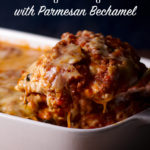



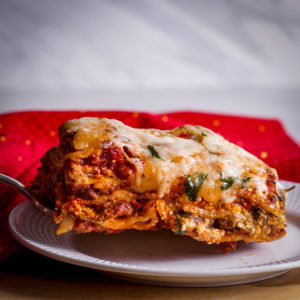
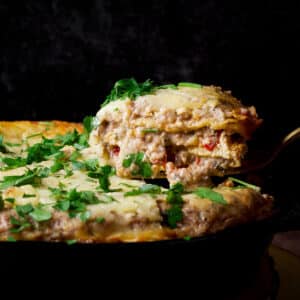
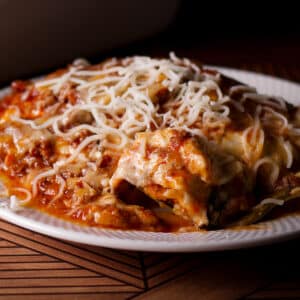
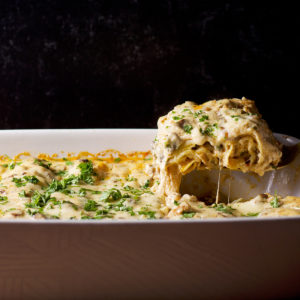
Susie says
It's been three months that my children have been begging me to recreate lasagna bolognese from one of our trips where this was apparently the best dish they ever had. Since then, I've been trying to follow various recipes and methods but cannot get it right. I've even asked my mom to help me because my kid's tantrums are off the roof, lol. This is LITERALLY the most amazing amazing amazing of the lot. My babies are still licking their fingers, and it turned out EXACTLY like what we tried on our trip. LOVE IT!!
RebeccaBlackwell says
I love this so much Susie!!! Your kiddos are lucky to have a momma who not only takes them to see new places but works so hard to recreate memorable meals from your travels! I am so happy to hear that you all liked this recipe so much. Thank you so much for taking the time to leave a comment for me. I truly appreciate it!